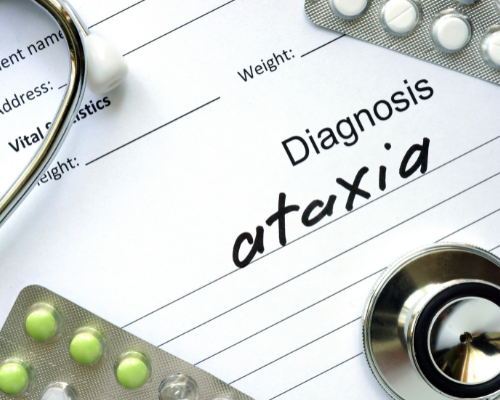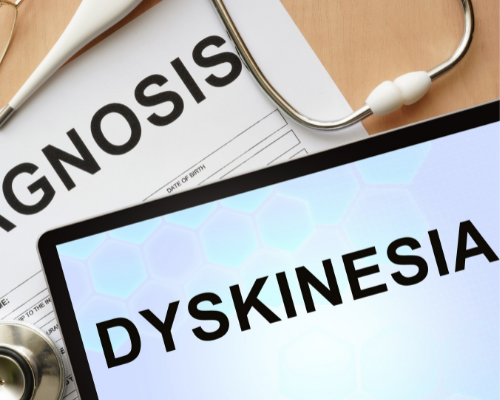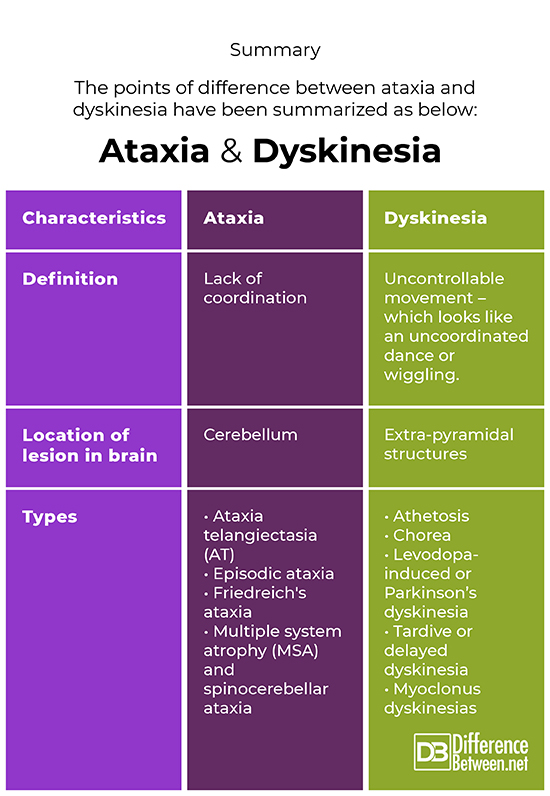Difference Between Ataxia and Dyskinesia
What is ataxia and dyskinesia?
Both are movement disorders. Ataxia is muscle incoordination and dyskinesia is a condition where the patient experiences difficulty in performing voluntary movements.
Similarity
Both are conditions involving muscle movements

Ataxia
It means ‘lack of order’. In this condition, parts of the nervous system that control movement and balance are affected.

Dyskinesis
It is referred to as presence of either winging or uncontrolled, involuntary muscle movement.
Difference between ataxia and dyskinesis
Definition
Ataxia
Ataxia is defined as group of movement disorders that include Impaired balance or coordination. The cause is damage to the spinal cord or other nerves. The symptoms include:
- Effect on balance and coordination
- Gait/posture abnormalities
- Fine motor incoordination
- Speech and swallowing difficulties
- Visual abnormalities
- Increased fatigue
- Cognitive and mood problems
Dyskinesis
Dyskinesia is a name given to a category of movement issues that are characterized by uncontrolled and involuntary muscle movements. Some symptoms include
- Wriggling
- Fidgeting
- Body swaying
- Twitching
- Bobbing of the head
- Restlessness
Symptoms
Ataxia
- Coordination and balance are affected first
- Slurry speech
- Eye movements that are too slow
- Vision issues
- Trouble and discomfort in walking, eating and writing
- Poor coordination of arms, legs, and hands
- Wide-based gait (Impaired balance with frequent falls)
- Heart problems
- Loss of fine motor skills
- Restlessness and twitching occur less often
- Difficulty with writing and eating
Dyskinesis
- Wriggling
- Twitching
- Swaying of the body
- Twitching
- Bobbing of the head
- Restlessness
Causes
Ataxia
It is a symptom of another health condition.
The causes include
- a vitamin B-12 deficiency
- an immunological problem
- a genetic feature
- a health condition that leads to nerve damage, such as a stroke or MS
It could also be inherited or non-inherited. Inherited ataxia is a cause of cerebellar ataxia. In non-inherited ataxia – the procedures and circumstances that can cause ataxia include – brain surgery, head injury, drug abuse, infections, brain tumor, malformation of the cerebellum while the baby is still in the womb, multiple sclerosis, cerebral palsy, and some other neurological conditions, exposure to toxic chemicals and alcohol abuse.
Dyskinesis
It is commonly caused by – medications, like levodopa in Parkinson’s disease and antipsychotic medications – Haloperidol, Fluphenazine, Risperidone (Risperdal), Olanzapine (Zyprexa).
Drugs that are used for treating reflux, stomach disorders, nausea, reflux can also result in dyskinesis if you consume them for more than these months. These include:
- Prochlorperazine (Compazine)
- Metoclopramide (Reglan)
Types
Ataxia
Ataxia telangiectasia (AT) – It is an inherited condition, also termed as Louis-Bar Syndrome. In this one ataxia-telangiectasia gene has been inherited from each parent. AT affects the nervous system, immune system, and other body systems
Episodic ataxia – It is the rarest form of ataxia and is a group of related conditions that impairs movement and causes recurrent episodes of poor coordination and balance
Friedreich’s ataxia – It is the most common type of ataxia caused by a problem in a gene called FXN. It is an inherited disorder that causes progressive nervous system damage
Multiple system atrophy (MSA) – It is a rare, degenerative neurological disorder (parkinsonism) that causes tremors, slow movement, and affects muscles making them stiff (rigid). It causes gradual damage to nerve cells in the brain
Spinocerebellar ataxia – a group of hereditary ataxias, characterized by slowly progressive problems with movement and incoordination of gait.
Dyskinesis
Athetosis – linked with brain damage, mainly cerebral palsy
Chorea – observed in Huntington’s disease, swift movements of the limbs and is similar dancing
Levodopa-induced or Parkinson’s dyskinesia – It happens due to long-term consumption of levodopa, a drug for treatment of Parkinson’s disease
Tardive or delayed dyskinesia – linked with the consumption of antipsychotic medications, used for treating schizophrenia
Myoclonus dyskinesias – movements are disabling and severe. Happens in progressive myoclonic encephalopathy
Summary
The points of difference between ataxia and dyskinesia have been summarized as below:

FAQ
What is the difference between ataxia and dystonia?
Ataxia is a degenerative disorder that causes uncoordinated or clumsy balance, speech or limb movements. Dystonia is – involuntary, slow, sustained contractions of agonist and sometimes also antagonist muscles producing twisting movements and/or abnormal posturing.
What is the difference between dyskinesia and dystonia?
Dyskinesia is involuntary, continuous muscle movements whereas dystonia is described as prolonged, involuntary muscle contractions
What is the difference between akathisia and dyskinesia?
In akinesia, the muscles cannot be moved (sometimes entirely). However, the ability of the muscles is not lost. It’s the extrapyramidal system (our motor control and coordination) or movement centers that are faulty. In dyskinesia, the muscles may move involuntarily, unexpectedly without the ability to stop.
Is dyskinesia the same as tardive dyskinesia?
No, dyskinesia is a general term coined to describe any unusual and abnormal involuntary movement. Whereas tardive dyskinesia means movements which are abnormal and involuntary that start after taking specific drugs that are used for addressing nausea and emotional disorders
- Difference Between Global Warming and Greenhouse Effect - May 18, 2024
- Difference Between Vaccination and Immunization - March 3, 2024
- Difference Between Selective Mutism and Autism - February 25, 2024
Search DifferenceBetween.net :
Leave a Response
References :
[0]Ashizawa, T., & Xia, G. (2016). Ataxia. Continuum: Lifelong Learning in Neurology, 22(4 Movement Disorders), 1208.
[1]Akbar, U., & Ashizawa, T. (2015). Ataxia. Neurologic clinics, 33(1), 225-248.
[2]Bastian, A. J. (1997). Mechanisms of ataxia. Physical therapy, 77(6), 672-675.
[3]Schooler, N. R., & Kane, J. M. (1982). Research diagnoses for tardive dyskinesia. Archives of general psychiatry, 39(4), 486-487.
[4]Kane, J. M., & Smith, J. M. (1982). Tardive dyskinesia: prevalence and risk factors, 1959 to 1979. Archives of General Psychiatry, 39(4), 473-481.
[5]Image credit: https://www.canva.com/photos/MADASlab3IM-tablet-with-diagnosis-dyskinesia-and-stethoscope-/
[6]Image credit: https://www.canva.com/photos/MADAop9m7oQ-diagnosis-ataxia-and-tablets-/
